Welcome to another edition where we show all of the costs for our 2014 Nissan Leaf SL electric vehicle (EV) to-date, which is 4.5 years now. This post is one in a series, the rest of which can be found at Cost Info Posts. Note that all costs are in $CDN.
First off, the usual detailed 6 month interval update, then a look at the forecast costs for the Leaf into the future (this edition with new charts), and lastly a surprise!
If you find this information of value, please consider a small donation via Patreon. Cheers!
Detailed Cost Report
Below is the regular table from previous posts:
The biggest change was “selling” the gas car (“Used ICE” column in orange) and buying a used Chevrolet Bolt EV, which so far is still the only long-range used EV available on the market (or even affordable new one! Though not for long…) Used prices, when you can even find them, are in the high 30’s. As you can tell at a glance, that would have been the more expensive way to go about the whole process… even if I were satisfied by the idea of buying a very similar Leaf to what I have now, my total cost would have been about the same (within a few thousand, up or down depending on exact year Leaf and trim).
The gas price did go up during this last period to an average of $1.44, the highest to-date, which increased the typical savings spread by ~$375. Crossing over the 100,000 mile mark (160,934) yielded the biggest scheduled service as well, at a whopping ~$600!! However, with the arrival of the Direct Current Fast Charging (DCFC) network, we have been making good use of it… spending about $225 in the last 6 months on about 65 charge sessions, which ate into our savings rate somewhat (now the question is, are those trips we would have done anyways with the fossil car, or are they new trips?) More to come on my DCFC insights from 2018 in a separate post!
Now to the graph of cumulative costs…
Flip back to the 4 year cost post for a moment and check out the two similar graphs, then come back.
Ok you’re back! You’ll notice that the graph above looks the most similar to the second graph I presented 6 months ago… yes that’s right, the Nissan Leaf is going into retirement. Sort of.
It has had a good run and served me well for my ~145 km daily commute, but the time had come to decide between buying a battery and continuing on with it as my commuter, or transitioning it to much less taxing city driving (by either using our gas car for my commute, or buying a longer range EV). For a wide variety of reasons, we decided to transition it to the much shorter city driving (it will amount to < 7,500 km/yr):
- My battery has degraded just under 20%, which meant that even leaving from work at 100% I was arriving home with only 5 – 10 km of range to spare this fall, so the range was no longer enough. Nissan increased the price of the battery replacement recently, and decided not to offer an upgrade in capacity. This is the primary reason. If I could have upgraded to the current 40 kWh battery (which is physically/structurally the same size), that would have been the first choice. I refuse to pay ~$10k for the same capacity the car was designed with almost 10 years ago. Nissan is trying to force consumers who have outgrown their gen 1 Leaf to buy a new Nissan Leaf… well that has really backfired on them and many people, including me, will not do so. (LEAF, by the way, stands for Leading Environmentally friendly Affordable Family car… buying a new car is not better Nissan![generally, see here for instances where it is!] )
- Following on point 1, even if I did replace the battery with the same capacity as the current one, I would still be needing to charge on Level 2 in the town I commute to, or use a fast charger twice per day at roughly the 2/3 and 1/3 point in the commute. This was cumbersome at the best of times without charging at work, and 8 months of the year we are engaged in after school/work activities that involve a decent amount of driving (to get to the nordic ski area and BMX track seasonally). My next commuter will be able to do the round-trip easily, with all the range to spare for eventual degradation, evening activities, and bad weather, probably for upwards of 15 – 20 years (i.e. the life of the car).
- Moving to a car that will do the round-trip saves me anywhere from 30 – 60 minutes of my day in walking to/from a charger and/or charging (especially in winter, when DCFC on a Leaf is S-L-O-W, more on that in a future post on DCFC). Time is one thing I can’t buy more of, and I’ve never been more acutely aware of that!
- Creature comforts – I spend 2 hours in the car each day, and the Leaf is decidedly cramped for a 6′ (182cm) guy (and there weren’t any other EVs to cross-shop it with at the time of purchase). It also does not have lumbar support, and my back is really noticing that.
However, none of the above items matter for the city driving in and around Nelson thankfully! The Leaf is a great car for booting around town and has been incredibly reliable, so we expect it to give many years of service in this capacity. Maybe in another 10 – 15 years when the original battery finally gives out, there will be affordable aftermarket choices to replace it.
- The Leaf will comfortably do my spouse’s daily trip requirements for many years to come on one charge, and often will go 2-3 days in between charging. When you are shopping for a new EV, I strongly recommend purchasing one that can do at least your regular round-trip commute (including regular side trips) with a buffer of at least 100% of that distance, using the EPA rated range as the value (not the manufacturer values). (Example: 100 km commute, buy a car with an EPA range of at least 200 km, because once you account for degradation of up to 20% over the life of the car and bad winter days that reduce your range by 30-50%… you’ll wish you had that extra range. Your mileage may vary of course, and take this advice with as many grains of salt as you want 😉
So with that in mind, the chart above has been updated to forecast the costs for in town trips as my spouse’s car. And guess what! Even with this transition, we’ll still be saving money over the other choices I had to make 4.5 years ago.
However, most of you reading these posts on the Nissan Leaf are likely considering buying one used, so I’ve added included a few charts below that you can use to forecast a few of your own scenarios, for example:
- Selling your gas car/SUV/truck and trading straight across to a Nissan Leaf (or other similar cost used EV, see “Available EVs in Canada” for some other ideas).
- Selling your gas car and spending $2k more for an EV; or $4k more, $6k more, $10k more, or even $20k more!
- Take a look at how long it takes for you to recoup your cost outlay, and check out your future savings potential!
- There is one chart for replacing a typical car, another for replacing a mid-sized SUV, and another for replacing a pickup. Consider whether you truly need your AWD lifted SUV/truck – some of you legitimately do, others less so. I’ve been pleasantly surprised at what I’ve been able to do in my Leaf, and it has made me reconsider what I need in a vehicle (more in that future post on the next EV).
- (And if you’re curious, we fit in between the 1st and 2nd column on the middle table, we are replacing a 2011 Subaru Forester with the 2014 Nissan Leaf, and the Subaru is worth more [sadly for us, good for you in the used EV market!], so we save money on this switch from day 1!)
Ok, no surprise that if you switch from a vehicle using more gas to an EV, that despite being in the same size class uses essentially the same amount of energy, you’ll get a payback quicker.
But check out the pickup graph below! I hope you get a lot of “truck” use out of that vehicle, otherwise it is costing you a small fortune for nothing. I realize this isn’t an apples-to-apples comparison, but do consider whether your current vehicle is necessary for your use pattern, or if you can just rent a bigger/stronger vehicle periodically (and still save a bundle!)
Phew, that was a long post!!
- R1T Efficiency Tests: Bikes and Ski Boxes - March 30, 2024
- Adding Outdoor Accessories to my R1T - December 1, 2023
- Why an EV truck? Why the R1T? - October 8, 2023
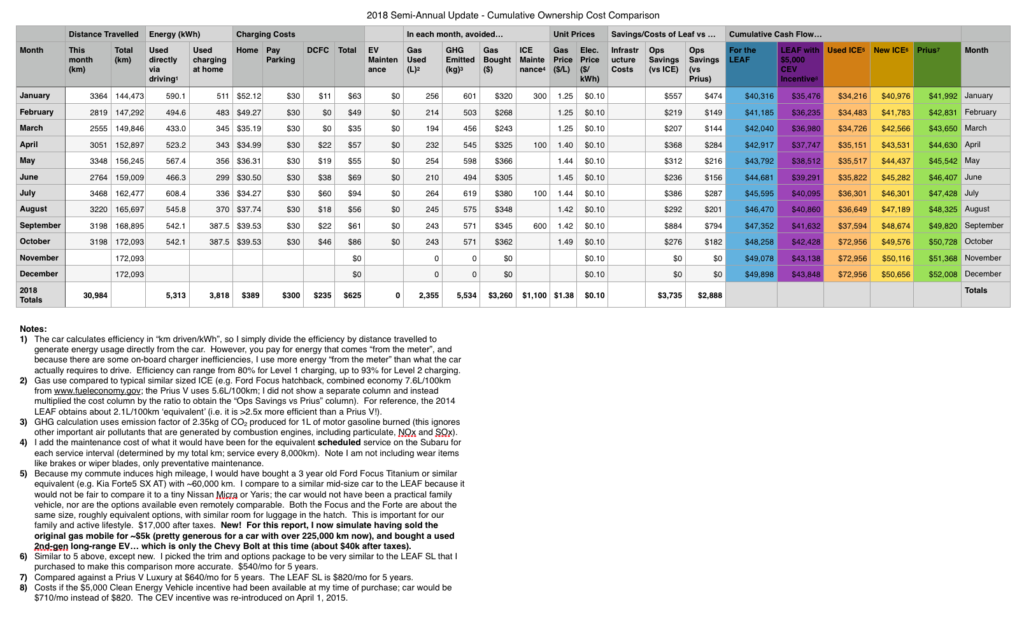
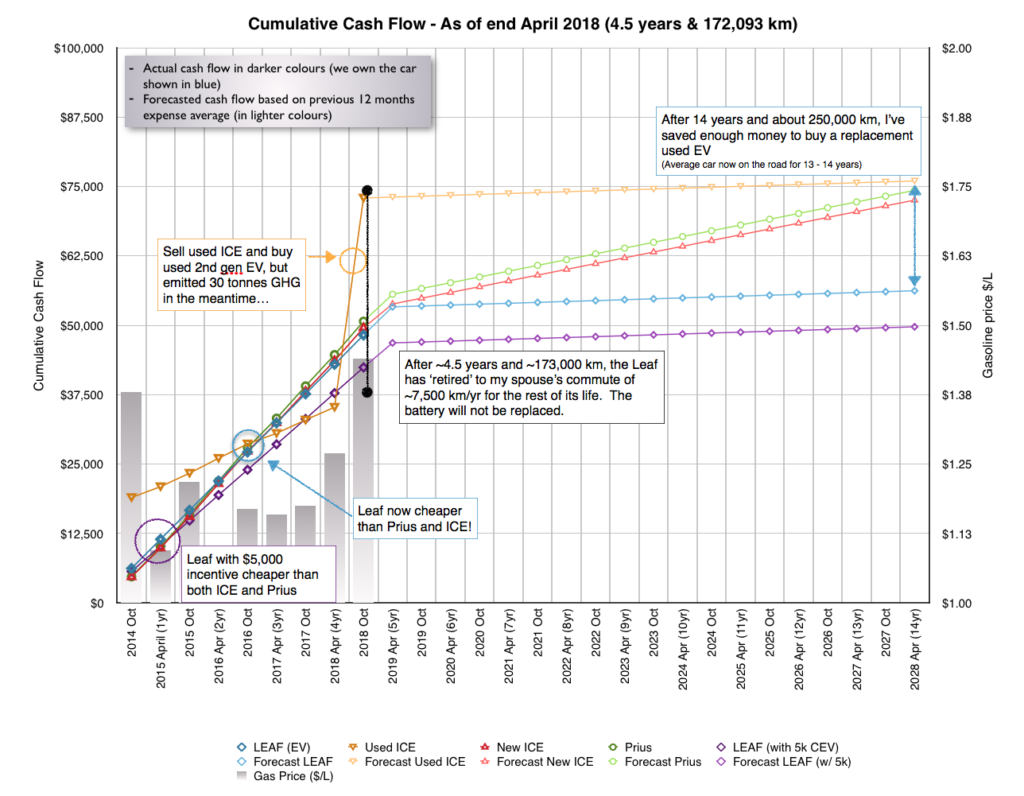
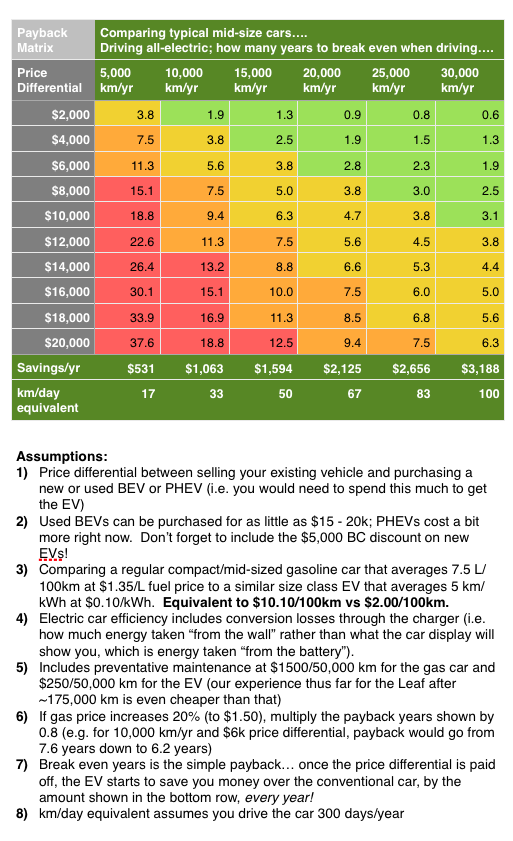
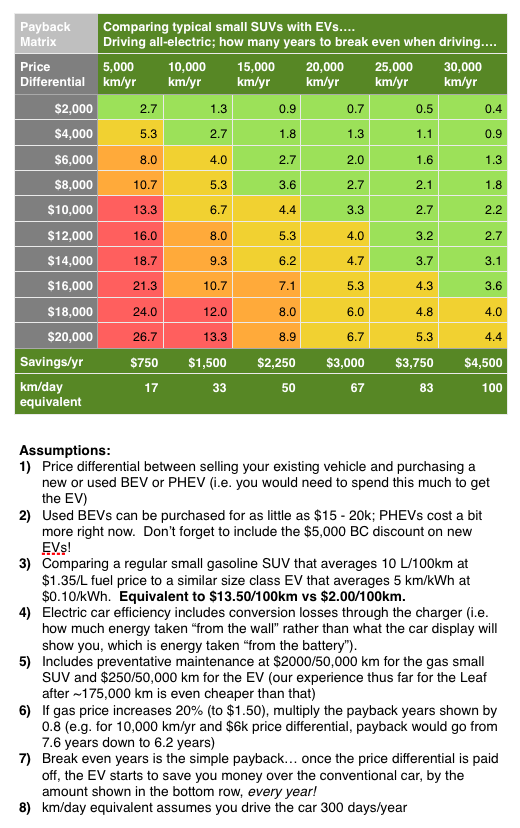
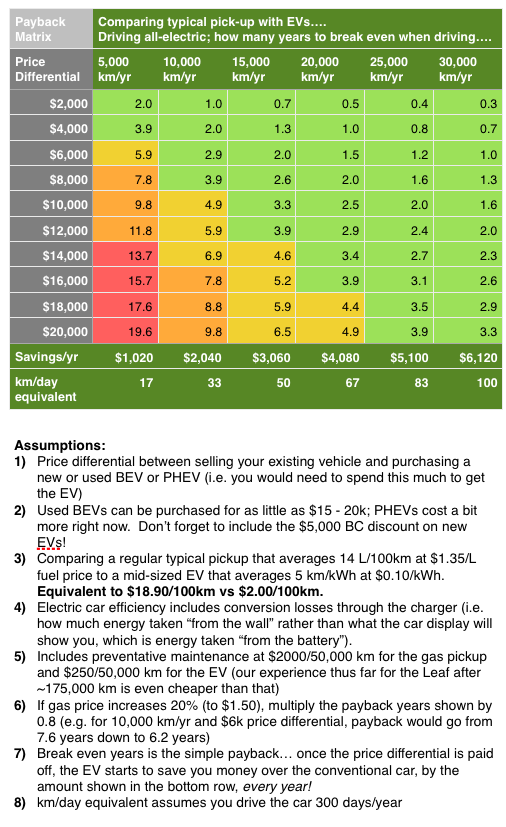
Pingback: So what are we getting? – Kootenay EV Family
Pingback: We bought a…. – Kootenay EV Family